four wheel drive Hyundai Equus 2016 Owner's Manual
[x] Cancel search | Manufacturer: HYUNDAI, Model Year: 2016, Model line: Equus, Model: Hyundai Equus 2016Pages: 477, PDF Size: 16.25 MB
Page 323 of 477
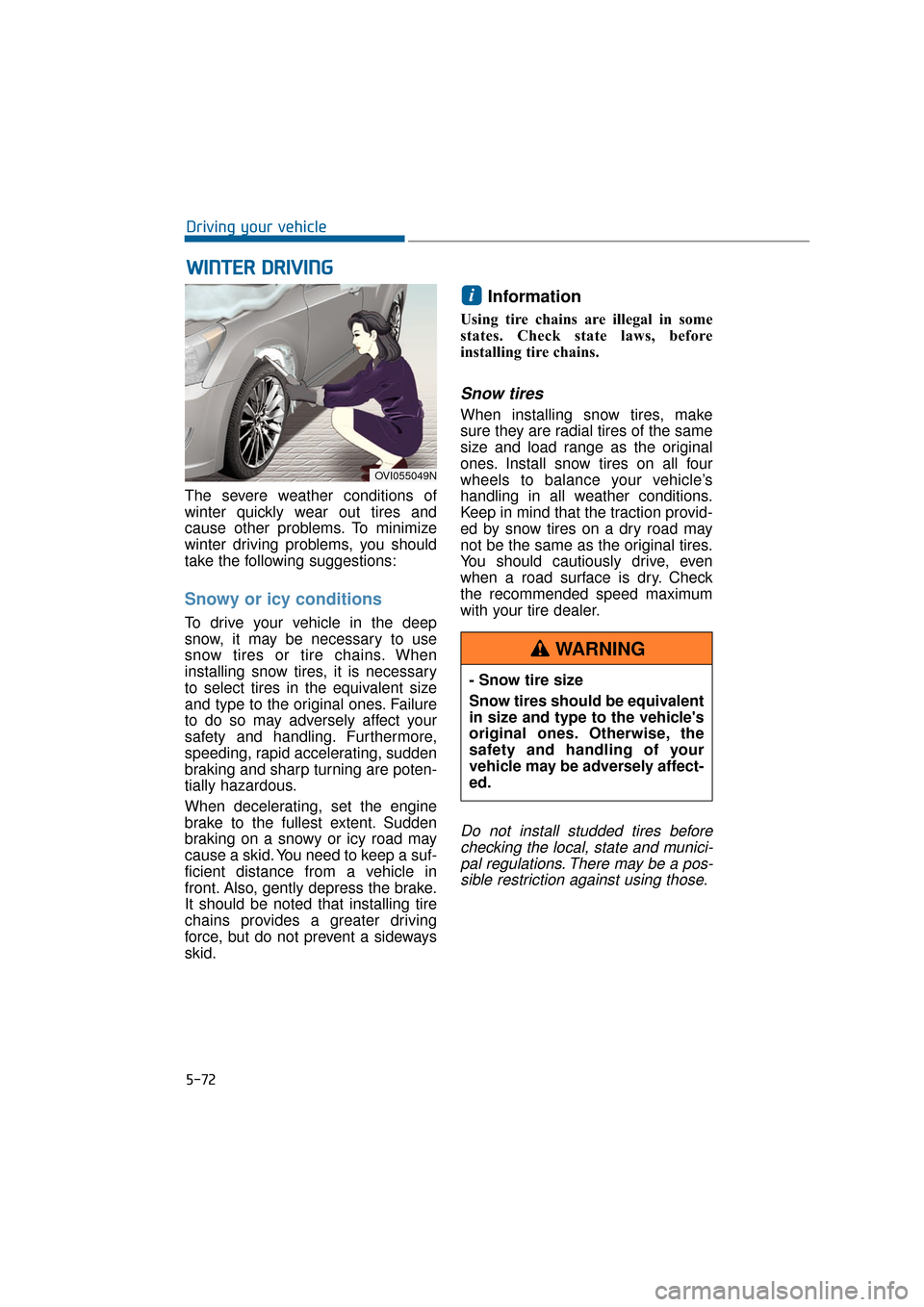
5-72
Driving your vehicle
The severe weather conditions of
winter quickly wear out tires and
cause other problems. To minimize
winter driving problems, you should
take the following suggestions:
Snowy or icy conditions
To drive your vehicle in the deep
snow, it may be necessary to use
snow tires or tire chains. When
installing snow tires, it is necessary
to select tires in the equivalent size
and type to the original ones. Failure
to do so may adversely affect your
safety and handling. Furthermore,
speeding, rapid accelerating, sudden
braking and sharp turning are poten-
tially hazardous.
When decelerating, set the engine
brake to the fullest extent. Sudden
braking on a snowy or icy road may
cause a skid. You need to keep a suf-
ficient distance from a vehicle in
front. Also, gently depress the brake.
It should be noted that installing tire
chains provides a greater driving
force, but do not prevent a sideways
skid.
Information
Using tire chains are illegal in some
states. Check state laws, before
installing tire chains.
Snow tires
When installing snow tires, make
sure they are radial tires of the same
size and load range as the original
ones. Install snow tires on all four
wheels to balance your vehicle’s
handling in all weather conditions.
Keep in mind that the traction provid-
ed by snow tires on a dry road may
not be the same as the original tires.
You should cautiously drive, even
when a road surface is dry. Check
the recommended speed maximum
with your tire dealer.
Do not install studded tires before checking the local, state and munici-pal regulations. There may be a pos-sible restriction against using those.
i
W W I
IN
N T
TE
ER
R
D
D R
RI
IV
V I
IN
N G
G
OVI055049N
- Snow tire size
Snow tires should be equivalent
in size and type to the vehicle's
original ones. Otherwise, the
safety and handling of your
vehicle may be adversely affect-
ed.
WARNING
Page 357 of 477
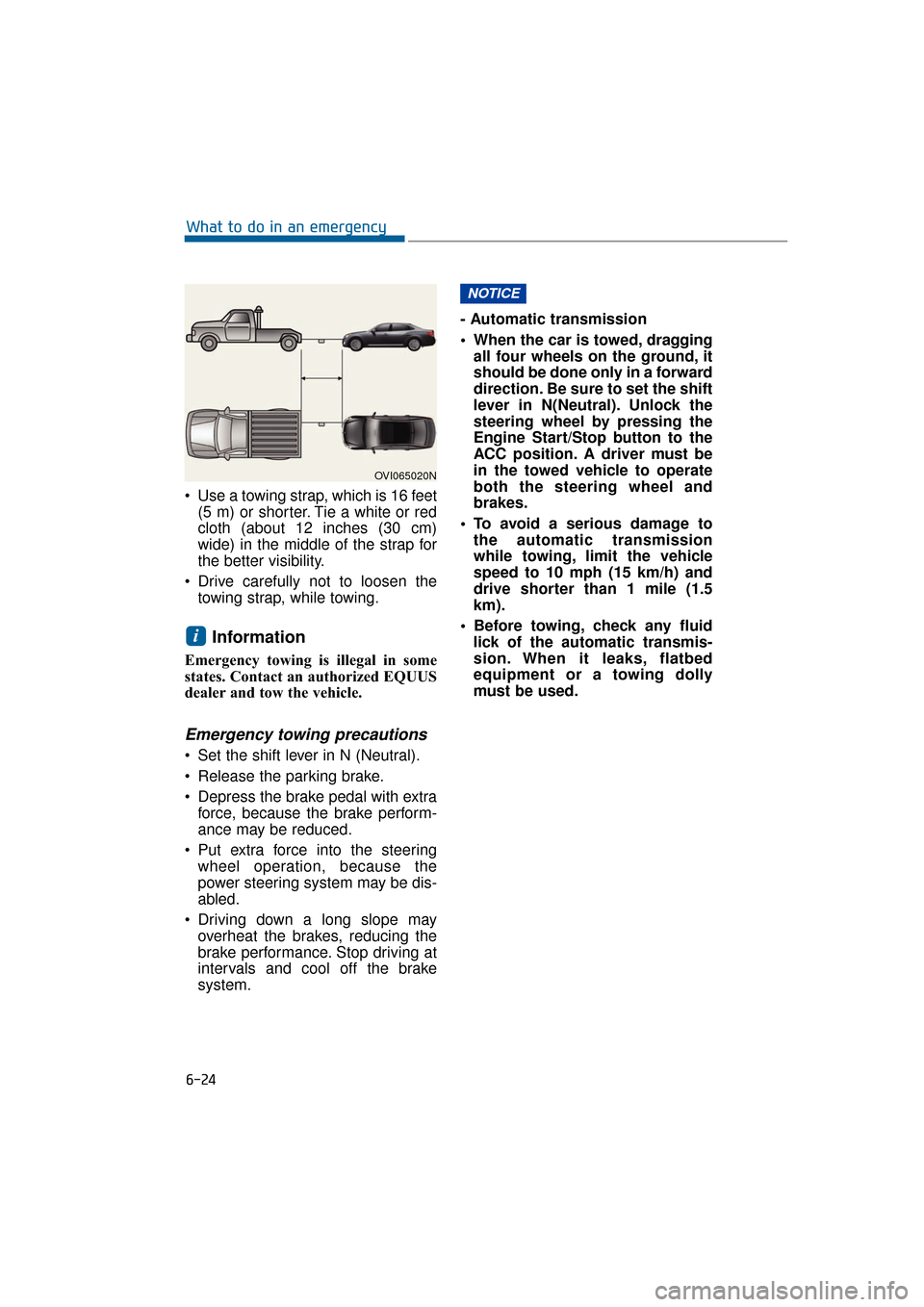
Use a towing strap, which is 16 feet(5 m) or shorter. Tie a white or red
cloth (about 12 inches (30 cm)
wide) in the middle of the strap for
the better visibility.
Drive carefully not to loosen the towing strap, while towing.
Information
Emergency towing is illegal in some
states. Contact an authorized EQUUS
dealer and tow the vehicle.
Emergency towing precautions
Set the shift lever in N (Neutral).
Release the parking brake.
Depress the brake pedal with extraforce, because the brake perform-
ance may be reduced.
Put extra force into the steering wheel operation, because the
power steering system may be dis-
abled.
Driving down a long slope may overheat the brakes, reducing the
brake performance. Stop driving at
intervals and cool off the brake
system. - Automatic transmission
When the car is towed, dragging
all four wheels on the ground, it
should be done only in a forward
direction. Be sure to set the shift
lever in N(Neutral). Unlock the
steering wheel by pressing the
Engine Start/Stop button to the
ACC position. A driver must be
in the towed vehicle to operate
both the steering wheel and
brakes.
To avoid a serious damage to the automatic transmission
while towing, limit the vehicle
speed to 10 mph (15 km/h) and
drive shorter than 1 mile (1.5
km).
Before towing, check any fluid lick of the automatic transmis-
sion. When it leaks, flatbed
equipment or a towing dolly
must be used.
NOTICE
i
6-24
What to do in an emergency
OVI065020N
Page 406 of 477
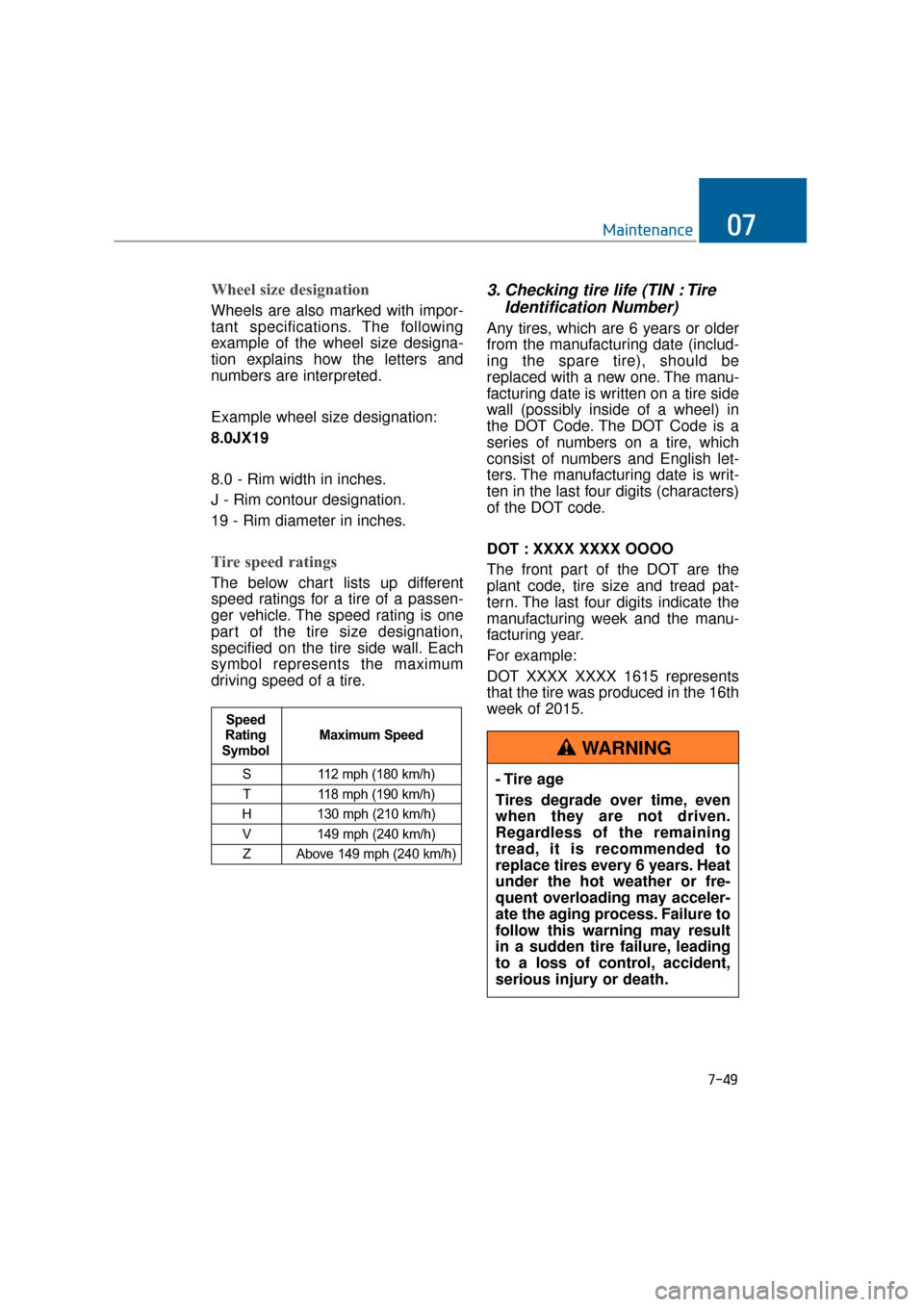
7-49
Maintenance07
Wheel size designation
Wheels are also marked with impor-
tant specifications. The following
example of the wheel size designa-
tion explains how the letters and
numbers are interpreted.
Example wheel size designation:
8.0JX19
8.0 - Rim width in inches.
J - Rim contour designation.
19 - Rim diameter in inches.
Tire speed ratings
The below chart lists up different
speed ratings for a tire of a passen-
ger vehicle. The speed rating is one
part of the tire size designation,
specified on the tire side wall. Each
symbol represents the maximum
driving speed of a tire.
3. Checking tire life (TIN : TireIdentification Number)
Any tires, which are 6 years or older
from the manufacturing date (includ-
ing the spare tire), should be
replaced with a new one. The manu-
facturing date is written on a tire side
wall (possibly inside of a wheel) in
the DOT Code. The DOT Code is a
series of numbers on a tire, which
consist of numbers and English let-
ters. The manufacturing date is writ-
ten in the last four digits (characters)
of the DOT code.
DOT : XXXX XXXX OOOO
The front part of the DOT are the
plant code, tire size and tread pat-
tern. The last four digits indicate the
manufacturing week and the manu-
facturing year.
For example:
DOT XXXX XXXX 1615 represents
that the tire was produced in the 16th
week of 2015.
S 112 mph (180 km/h)
T 118 mph (190 km/h)
H 130 mph (210 km/h) V 149 mph (240 km/h)Z Above 149 mph (240 km/h)
Maximum Speed
Speed
Rating
Symbol
- Tire age
Tires degrade over time, even
when they are not driven.
Regardless of the remaining
tread, it is recommended to
replace tires every 6 years. Heat
under the hot weather or fre-
quent overloading may acceler-
ate the aging process. Failure to
follow this warning may result
in a sudden tire failure, leading
to a loss of control, accident,
serious injury or death.
WARNING
Page 411 of 477
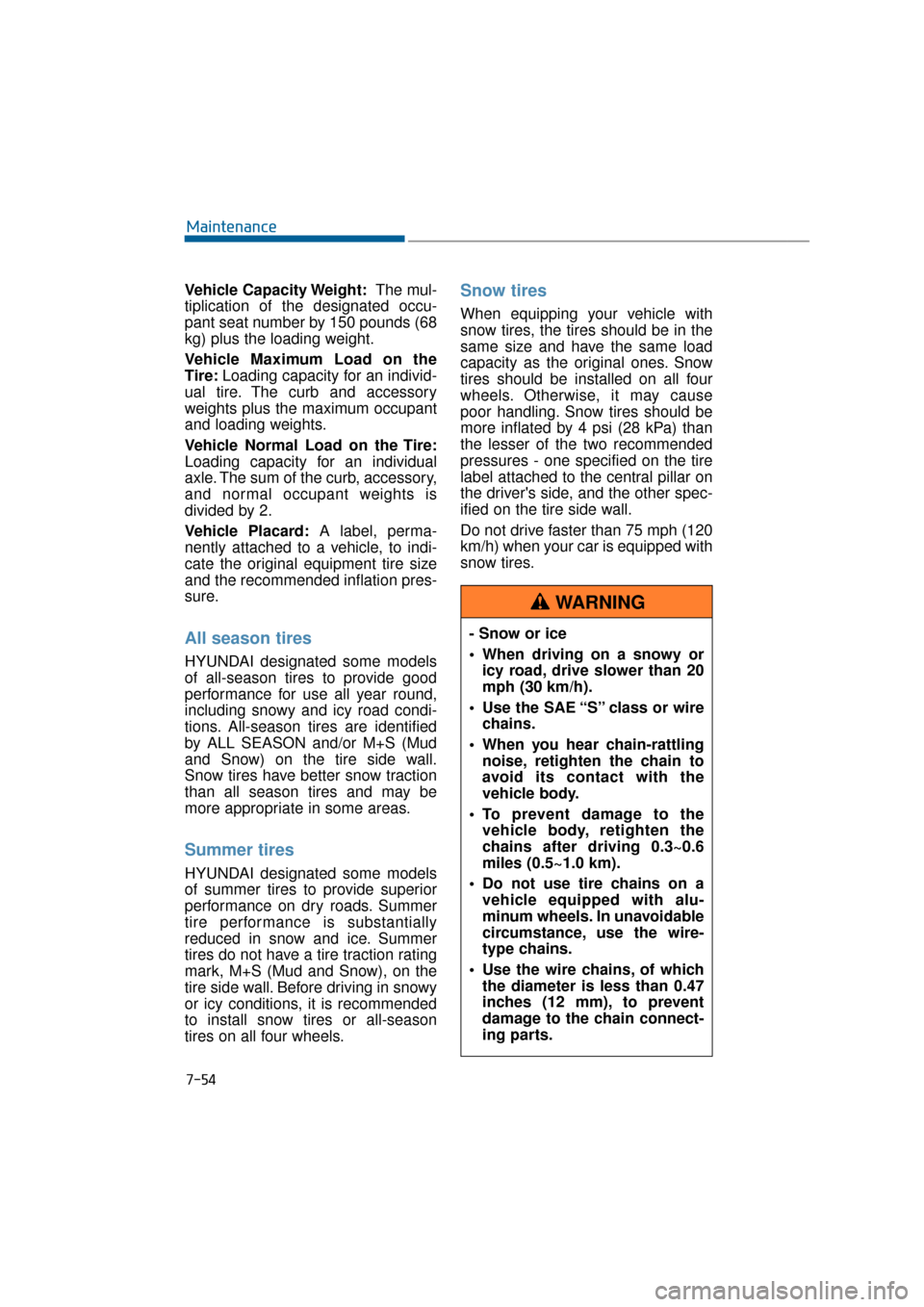
7-54
Maintenance
Vehicle Capacity Weight: The mul-
tiplication of the designated occu-
pant seat number by 150 pounds (68
kg) plus the loading weight.
Vehicle Maximum Load on the
Tire: Loading capacity for an individ-
ual tire. The curb and accessory
weights plus the maximum occupant
and loading weights.
Vehicle Normal Load on the Tire:
Loading capacity for an individual
axle. The sum of the curb, accessory,
and normal occupant weights is
divided by 2.
Vehicle Placard: A label, perma-
nently attached to a vehicle, to indi-
cate the original equipment tire size
and the recommended inflation pres-
sure.
All season tires
HYUNDAI designated some models
of all-season tires to provide good
performance for use all year round,
including snowy and icy road condi-
tions. All-season tires are identified
by ALL SEASON and/or M+S (Mud
and Snow) on the tire side wall.
Snow tires have better snow traction
than all season tires and may be
more appropriate in some areas.
Summer tires
HYUNDAI designated some models
of summer tires to provide superior
performance on dry roads. Summer
tire performance is substantially
reduced in snow and ice. Summer
tires do not have a tire traction rating
mark, M+S (Mud and Snow), on the
tire side wall. Before driving in snowy
or icy conditions, it is recommended
to install snow tires or all-season
tires on all four wheels.
Snow tires
When equipping your vehicle with
snow tires, the tires should be in the
same size and have the same load
capacity as the original ones. Snow
tires should be installed on all four
wheels. Otherwise, it may cause
poor handling. Snow tires should be
more inflated by 4 psi (28 kPa) than
the lesser of the two recommended
pressures - one specified on the tire
label attached to the central pillar on
the driver's side, and the other spec-
ified on the tire side wall.
Do not drive faster than 75 mph (120
km/h) when your car is equipped with
snow tires.
- Snow or ice
When driving on a snowy or icy road, drive slower than 20
mph (30 km/h).
Use the SAE “S” class or wire chains.
When you hear chain-rattling noise, retighten the chain to
avoid its contact with the
vehicle body.
To prevent damage to the vehicle body, retighten the
chains after driving 0.3~0.6
miles (0.5~1.0 km).
Do not use tire chains on a vehicle equipped with alu-
minum wheels. In unavoidable
circumstance, use the wire-
type chains.
Use the wire chains, of which the diameter is less than 0.47
inches (12 mm), to prevent
damage to the chain connect-
ing parts.
WARNING
Page 412 of 477
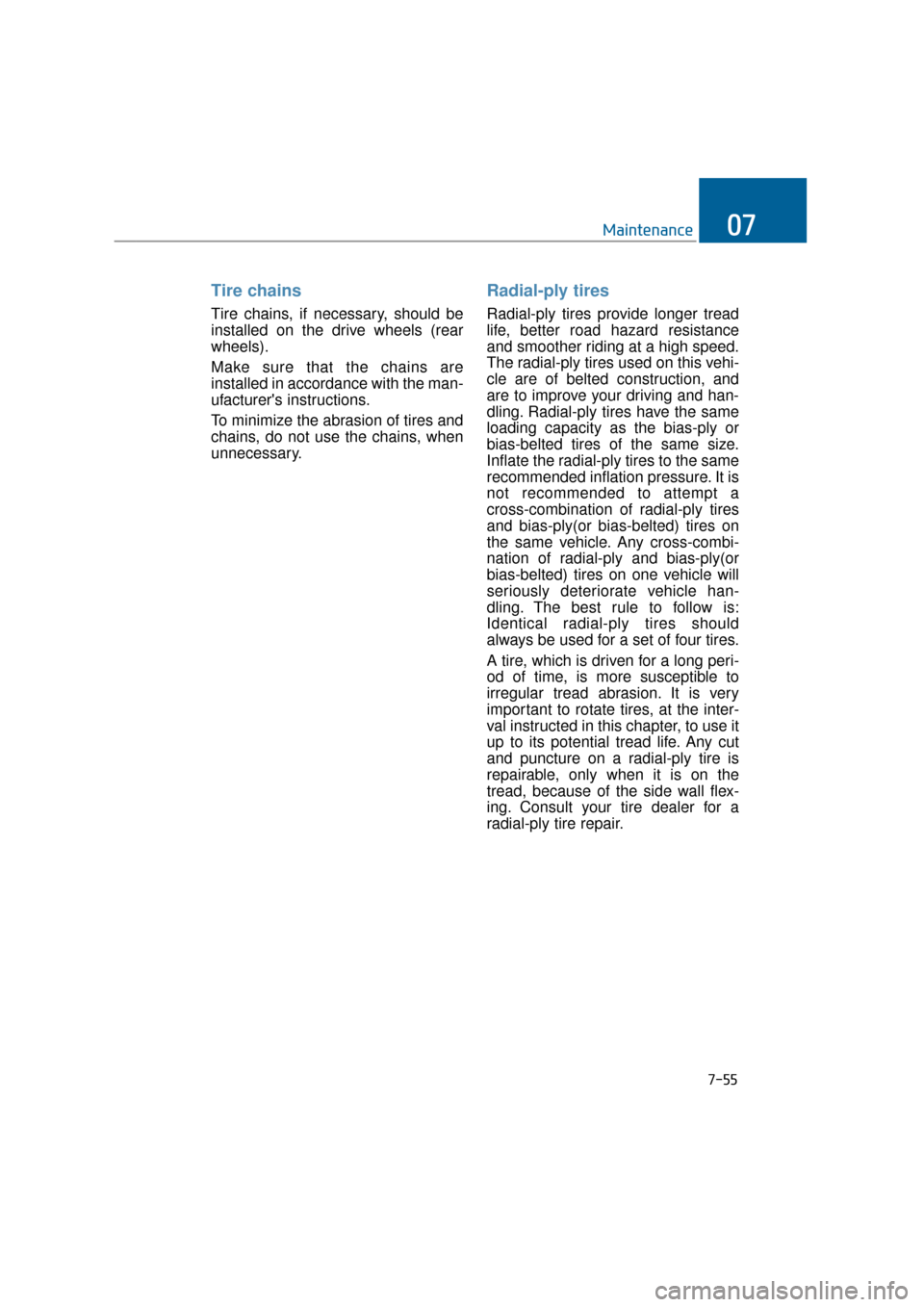
7-55
Maintenance07
Tire chains
Tire chains, if necessary, should be
installed on the drive wheels (rear
wheels).
Make sure that the chains are
installed in accordance with the man-
ufacturer's instructions.
To minimize the abrasion of tires and
chains, do not use the chains, when
unnecessary.
Radial-ply tires
Radial-ply tires provide longer tread
life, better road hazard resistance
and smoother riding at a high speed.
The radial-ply tires used on this vehi-
cle are of belted construction, and
are to improve your driving and han-
dling. Radial-ply tires have the same
loading capacity as the bias-ply or
bias-belted tires of the same size.
Inflate the radial-ply tires to the same
recommended inflation pressure. It is
not recommended to attempt a
cross-combination of radial-ply tires
and bias-ply(or bias-belted) tires on
the same vehicle. Any cross-combi-
nation of radial-ply and bias-ply(or
bias-belted) tires on one vehicle will
seriously deteriorate vehicle han-
dling. The best rule to follow is:
Identical radial-ply tires should
always be used for a set of four tires.
A tire, which is driven for a long peri-
od of time, is more susceptible to
irregular tread abrasion. It is very
important to rotate tires, at the inter-
val instructed in this chapter, to use it
up to its potential tread life. Any cut
and puncture on a radial-ply tire is
repairable, only when it is on the
tread, because of the side wall flex-
ing. Consult your tire dealer for a
radial-ply tire repair.